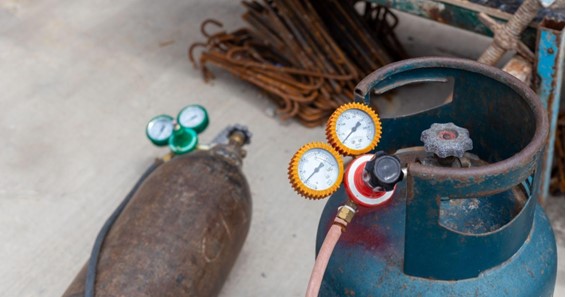What are LPG regulators?
An LPG regulator is a device designed to control and regulate the flow of liquefied petroleum gas from a high-pressure source, such as a gas cylinder or tank, to a lower pressure suitable for various applications. You can ask your LPG gas supplier Brisbane for reliable regulators that suit your gas bottle.
The primary function of an LPG regulator is to reduce the high-pressure gas from the cylinder or tank to a consistent and safe pressure that appliances can utilise. This pressure reduction is crucial to prevent appliance damage and ensure a controlled and efficient burn.
LPG regulators typically consist of a housing, an inlet connection to receive gas from the high-pressure source, an outlet connection to deliver regulated gas, and an adjustable valve or diaphragm mechanism.
Inside the regulator are various components, including springs, valves, diaphragms, and pressure sensors, all working together to regulate and maintain a constant outlet pressure.
So the question now is…
How do LPG regulators work?
Step 1: Gas Inlet
The first step in how LPG regulators work their wonders begins with the gas inlet. This is where the high-pressure liquefied petroleum gas (LPG) enters the regulator. Imagine this as the gateway where the raw power of the gas is about to be tamed and transformed.
Step 2: Pressure-Reducing Chamber
Once inside the regulator, the high-pressure gas encounters a pressure-reducing chamber. This chamber is like a controlled environment where the real magic happens. It houses an intricate mechanism that will handle the raw power of the gas and convert it into a regulated and safe flow.
Step 3: Diaphragm and Spring
We find the dynamic duo at the heart of the pressure-reducing chamber: the diaphragm and the spring: the diaphragm, a flexible membrane, and the spring work together to maintain a delicate balance. As the gas pressure fluctuates, the diaphragm and spring respond accordingly to ensure a consistent outlet pressure.
Step 4: Pressure Sensing
To maintain the desired outlet pressure, LPG regulators employ a pressure-sensing mechanism. This mechanism monitors the outlet pressure and provides feedback to the diaphragm and spring. It’s like having a vigilant guardian that watches the gas flow, ready to adjust.
Step 5: Valve Control
Regulating the flow of gas requires precise control, and that’s where valves come into play. The LPG regulator has valves that can open or close, allowing more or less gas to pass through. These valves respond to the signals from the pressure sensing mechanism, fine-tuning the gas flow to meet the desired pressure requirements.
Step 6: Safety Measures
Safety is paramount when dealing with LPG, and regulators incorporate various safety measures to protect users and property. One crucial safety feature is the pressure relief valve. This valve acts as a safety release, opening automatically if the pressure exceeds a specific limit, diverting excess gas and preventing potential hazards.
Step 7: Gas Outlet
After going through the pressure-reducing chamber and various control mechanisms, the now regulated and controlled gas flows through the gas outlet. The gas has transformed from a high-pressure powerhouse to a gentle, safe flow ready to power our appliances.
Step 8: Consistent and Safe Gas Flow
LPG regulators ensure a consistent and safe gas flow thanks to the collaborative efforts of the diaphragm, spring, pressure sensing mechanism, valves, and safety features. They tame the raw power of LPG, transforming it into a controlled stream that can be used for cooking, heating, or any other application that requires LPG.
Click here – 13 Ways to Protect Your Car Paint
How safe is it to use LPG regulators?
LPG regulators are generally considered safe when properly installed, maintained, and used according to the manufacturer’s instructions. LPG regulators are designed with safety in mind and undergo rigorous testing to meet industry standards and regulations.
However, it is important to remain cautious and vigilant when using LPG.
- Ensure proper cylinder handling and storage, including secure placement and protection from heat sources or direct sunlight.
- Regularly check for gas leaks using soapy water or a leak detection solution on connections and fittings.
- Avoid using damaged or expired regulators and have them replaced or repaired by qualified professionals.
- Follow the manufacturer’s instructions for operating LPG appliances and regulators, including proper ignition procedures and ventilation requirements.
- In case of suspected gas leaks or emergencies, promptly evacuate the area, avoid open flames or sparks, and contact the relevant emergency services.
Takeaway
Keeping your kitchen safe is of utmost importance, and using LPG regulators plays a vital role in achieving this goal. These remarkable devices control and regulate liquefied petroleum gas, ensuring a safe and consistent flow to power your appliances.
You can minimise the risk of gas-related incidents in your kitchen by choosing a reliable LPG regulator, installing it correctly, and maintaining it regularly. Practising suitable LPG safety measures such as proper cylinder handling, regular leak checks, and understanding emergency procedures enhances kitchen safety.
Most importantly, purchase your residential LPG bottle from a reputable supplier like Plus Gas in Brisbane. So, embrace the wonders of LPG regulators and cook confidently, knowing that you have taken the necessary steps to keep your kitchen safe and secure.
Happy Cooking!

